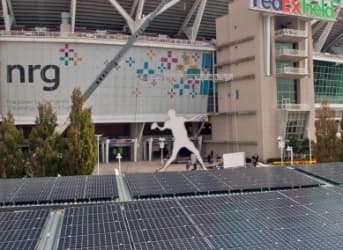NRG Energy is charting a path forward for the 21st century utility.
The threat of distributed energy has raised concerns in utility boardrooms over the future of their business model. In particular, rooftop solar threatens to upend the economics of regulated utilities. The U.S. now has more than 15 gigawatts of solar power installed across the country, a rounding error when compared to the entire electric power sector, but the vast majority of which has come online in the last few years.
Solar power is growing quickly – over half a million people installed solar panels on their homes in the first half of 2014. And with panel prices and the overall cost of installation continuing to drop, those numbers will pick up pace in the coming years.
For every kilowatt-hour that a homeowner generates on their own through a solar PV panel, that is a kilowatt-hour that the utility no longer earns money from. As a result, utilities have gone on the offensive, trying to erect barriers to new solar installations.
Related: The Cold, Hard Truth About Renewables
Just this month, the state of Wisconsin voted to allow We Energies, the local utility, to raise fees on homes with solar panels, charging them an extra $3.79 per month plus reduced payments for net metering. The result will be an additional $230 per year for homeowners with a five kilowatt solar system.
That is just one example of a broader campaign to slow solar development.
NRG may be the exception. NRG CEO David Crane in the past has admitted that utilities recognize that “distributed solar is a mortal threat to their business.” Recognizing this, Crane and NRG are getting in the game rather than fighting it. The utility – which owns a mixture of coal, natural gas, solar and wind-powered generation – has vowed to go big on solar and offer incentives to its customers to buy NRG solar panels.
It announced on November 18 that it is opening two new offices in California to grow its solar business. “We are in this residential solar space to win, and this is evidence of our commitment to become a big player in the state of California,” Kelcy Pegler, President of NRG Home Solar, said in an interview with Reuters.
NRG recently purchased Roof Diagnostics Solar, a solar PV installer, and Pure Energies, a solar sales company. NRG is aiming to have 10,000 solar installations by the end of 2014, which the company expects to quadruple to nearly 40,000 by the end of next year.
And it plans on copying the lease model pioneered by rival SolarCity – requiring no upfront costs, and just charging ratepayers a monthly fee for the solar panels.
Immediately after NRG’s solar announcement, the company made another stunning move. It announced a pledge to reduce its greenhouse gas emissions by 50 percent by 2030 and 90 percent by mid-century. NRG has already cut its emissions by 40% since 2005.
Related: California Public Utilities Vote No On Energy Storage
“The power industry is the biggest part of the problem of greenhouse gas emissions, but it has the potential to be an even bigger part of the solution,” Crane told the New York Times.
NRG is the largest independent power producer in the country and has 21 coal-fired power plants in its portfolio. In order to reduce its emissions from these plants, it is building the largest carbon capture and sequestration facility in Texas. The Petra Nova carbon capture project will capture 90% of the emissions from one of NRG’s coal plants when it is completed in 2016.
The economics of carbon capture are still up in the air because so few have been constructed. NRG hopes to scale up the technology and bring down costs which will allow it to keep its coal fleet viable in an era of tightening EPA restrictions. If that doesn’t work, NRG may need to rely much more heavily on renewable energy to avoid falling into the so-called “utility death spiral.”
Nevertheless, unlike its competitors, NRG is trying to adapt to the 21st century by being at the forefront of the evolving electric power sector.
By Nick Cunningham of Oilprice.com
More Top Reads From Oilprice.com:
- More Battery Storage Would Improve Texas Grid
- The Appalling Truth About Energy Subsidies
- Renewable Energy vs Natural Gas – How The Costs Stack Up


















